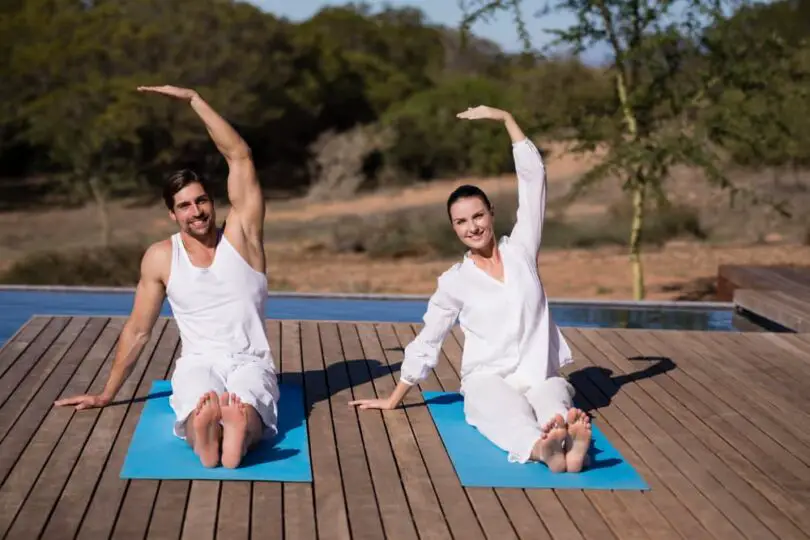Yoga is a practice that benefits individuals and can be incredibly rewarding when done with a partner. Yoga poses for two people, often called partner or couples yoga, bring various physical, emotional, and relational benefits. Whether you want to improve your flexibility, boost your mood, or strengthen your relationship, practicing yoga with a partner can offer all these advantages and more.
Table of Contents
Physical Benefits
Introduction to Physical Benefits
Practicing yoga with a partner provides numerous physical benefits. Partner yoga poses can significantly improve your physical health, from enhancing flexibility to building strength.
Increased Flexibility
Partner yoga poses are fantastic for increasing flexibility. When you stretch with a partner, you can achieve deeper stretches and improve your range of motion more effectively than when practicing alone. Poses like the Seated Forward Bend and Double Downward Dog help both partners stretch their hamstrings, shoulders, and back.
Improved Strength
Yoga poses for two people can also help improve your strength. Supporting each other in poses like the Double Plank or Partner Boat Pose engages multiple muscle groups, making you stronger over time. When you lift and balance each other, you work on building muscle strength together.
Better Balance and Coordination
Partner yoga demands a lot of balance and coordination. Balancing poses such as the Partner Tree Pose or Double Dancer Pose require you to synchronize your movements and support each other. This not only improves your balance but also enhances your coordination.
Enhanced Body Awareness
Practicing yoga with a partner helps you develop better body awareness. When you move in unison and adjust to each other’s movements, you become more attuned to your own body. This heightened awareness can lead to better alignment and posture in your practice.
Injury Prevention
One of the significant benefits of yoga poses for two people is the potential for injury prevention. Having a partner to support you can reduce the risk of falling or overstretching. Moreover, partners can help ensure that you are performing poses correctly, thus preventing injuries.
By practicing partner yoga, you can experience these physical benefits while enjoying the added bonus of shared activity. It’s a win-win for both your body and your relationship.
Emotional and Mental Benefits
Introduction to Emotional Benefits
Practicing yoga poses with two people not only brings physical advantages but also offers significant emotional and mental benefits. These benefits can enhance one’s overall well-being and improve one’s connection with one’s partner.
Stress Reduction
One of the primary emotional benefits of partner yoga is stress reduction. The combination of physical activity, breathing exercises, and the presence of a supportive partner can significantly lower stress levels. Poses like the Partner Child’s Pose and Back-to-Back Breathing promote relaxation and help release tension.
Boosted Mood
Engaging in partner yoga can boost one’s mood. The endorphins released during physical activity, combined with the joy of shared experiences, can lift one’s spirits. Poses such as the Partner Forward Fold and Laughter Yoga are particularly effective in improving mood and creating a sense of happiness.
Increased Mindfulness
Yoga promotes mindfulness, and practicing with a partner can deepen this effect. Being mindful of each other’s movements and synchronizing your breath can enhance your awareness. Poses like the Seated Spinal Twist and Partner Meditation encourage you to stay present and fully engaged at the moment.
Improved Focus and Concentration
Practicing yoga with a partner requires a high level of focus and concentration. You need to stay attentive to your movements and those of your partner. This practice can sharpen your mental clarity and improve your ability to concentrate. Poses such as the Partner Warrior Pose and Supported Headstand demand and develop these skills.
Emotional Bonding
Partner yoga also strengthens emotional bonds. Sharing this practice allows you to connect deeper, fostering trust and intimacy. Poses like the Partner Heart Opener and Seated Butterfly help create a safe space for emotional sharing and support.
By incorporating partner yoga into your routine, you can enjoy these emotional and mental benefits, improving your personal well-being and enhancing your relationship.
Relational Benefits
Introduction to Relational Benefits
Yoga poses for two people offer more than just physical and emotional advantages; they also provide significant relational benefits. Practicing yoga with a partner can deepen your connection, improve communication, and strengthen your relationship.
Strengthened Communication
One key relational benefit of partner yoga is improved communication. The practice requires you to talk and listen to each other, ensuring you move in sync and support one another. Poses like the Partner Boat Pose and Double Downward Dog necessitate clear verbal and nonverbal communication, fostering better understanding and cooperation.
Enhanced Trust
Building trust is a fundamental aspect of any relationship, and partner yoga can help with this. When you support each other in poses, you learn to rely on your partner and vice versa. Trust-building poses such as the Double Plank and Partner Backbend reinforce trust in your relationship.
Increased Intimacy
Yoga for two people can also boost intimacy. The physical closeness and shared breathing exercises can help create a deeper emotional bond. Poses like the Seated Forward Fold and Partner Lotus Pose allow for intimate connection and closeness, enhancing your sense of togetherness.
Shared Experiences and Memories
Practicing yoga together creates shared experiences and lasting memories. These moments of teamwork and mutual support can strengthen your relationship over time. Fun and memorable poses like the Flying Warrior and Partner Handstand are perfect for creating unforgettable experiences.
Mutual Motivation and Accountability
When practicing yoga with a partner, you have someone to motivate and hold you accountable. This mutual encouragement can help you stay committed to your practice and reach your fitness goals. Poses that require cooperation, such as the Partner Warrior III and Tandem Crow Pose, emphasize the importance of teamwork and accountability.
By incorporating yoga poses for two people into your routine, you can enjoy these relational benefits, leading to a stronger and more connected partnership.
Getting Started with Partner Yoga
Choosing the Right Partner
Choosing the right partner is crucial for a successful and enjoyable yoga practice. Look for someone who shares similar goals and has a comparable fitness level. Compatibility and
clear communication are key to ensuring a smooth practice. Whether it’s a friend, family member, or significant other, the most important thing is that both of you are committed and willing to work together.
Preparing for Partner Yoga
Before diving into partner yoga, it’s important to prepare properly. Warm-up exercises help to loosen muscles and prevent injuries. Start with simple stretches like cat-cow, gentle twists, and forward bends to get your body ready. Also, consider using mats, comfortable attire, and any necessary props to support your practice.
Beginner-Friendly Poses
For those new to partner yoga, begin with easy poses that build trust and coordination. Here are a few to get you started:
- Seated Forward Bend: Sit facing each other with legs extended. Hold each other’s wrists and gently pull forward to stretch the hamstrings.
- Double Downward Dog: One partner starts in a downward dog position, while the other places their feet on the lower back of the first partner, also forming a downward dog.
- Partner Child’s Pose: One partner sits back on their heels in the child’s pose while the other gently presses down on their back, enhancing the stretch.
Intermediate and Advanced Poses
Once comfortable with the basics, you can progress to more challenging poses. These require more strength, balance, and coordination:
- Double Plank: One partner holds a plank position while the other places their feet on the first partner’s shoulders, holding a plank above them.
- Flying Warrior: The base lies on their back with legs extended, supporting the flyer’s hips with their feet as the flyer balances in a warrior pose.
- Tandem Crow Pose: Both partners get into a crow pose side by side, using each other’s shoulders for additional balance and support.
Safety Tips
Safety is paramount in partner yoga. Always communicate with your partner and use spotters when trying new or difficult poses. Start slow, and don’t push your body beyond its limits. Using mats and practicing in a safe environment can also help prevent injuries.
Partner yoga can be rewarding, providing numerous physical, emotional, and relational benefits. You can enjoy a fulfilling and connected yoga journey by choosing the right partner, preparing adequately, and starting with beginner-friendly poses.
Related Article: Yoga Poses for Two People: Double Downward Dog
FAQs
Q. Do I need a partner to do yoga poses for two people?
A. Yes, doing yoga poses for two people requires a partner. You can practice with a friend, family member, or significant other.
Q. Is it safe to practice yoga poses for 2 people?
A. As long as you practice within your limits and communicate with your partner, practicing yoga poses for two people can be safe.
Q. Can beginners practice yoga poses for two people?
A. Yes, beginners can practice yoga poses for 2 people, but it’s essential to start with simple poses and communicate with your partner about any limitations.
Conclusion
Practicing yoga poses for two people offers a wealth of benefits that extend beyond physical fitness. It strengthens bonds, improves communication, and builds trust between partners. The emotional and mental benefits, such as reduced stress and increased mindfulness, enhance overall well-being. Relational benefits, like shared experiences and mutual motivation, deepen connections and create lasting memories.







